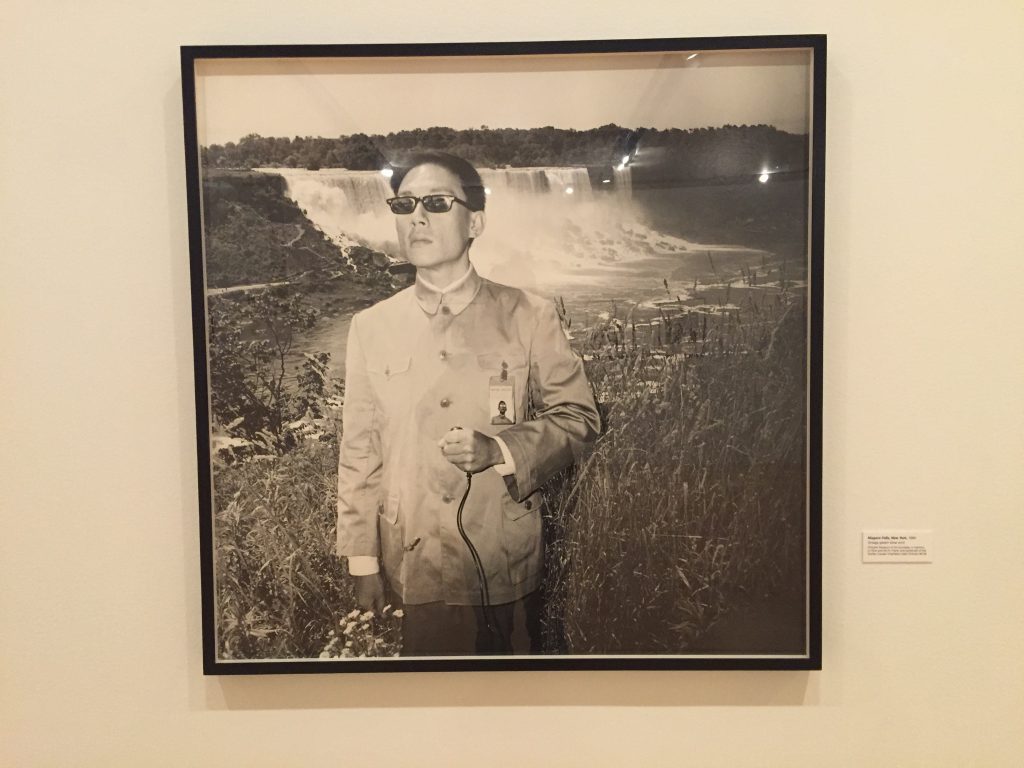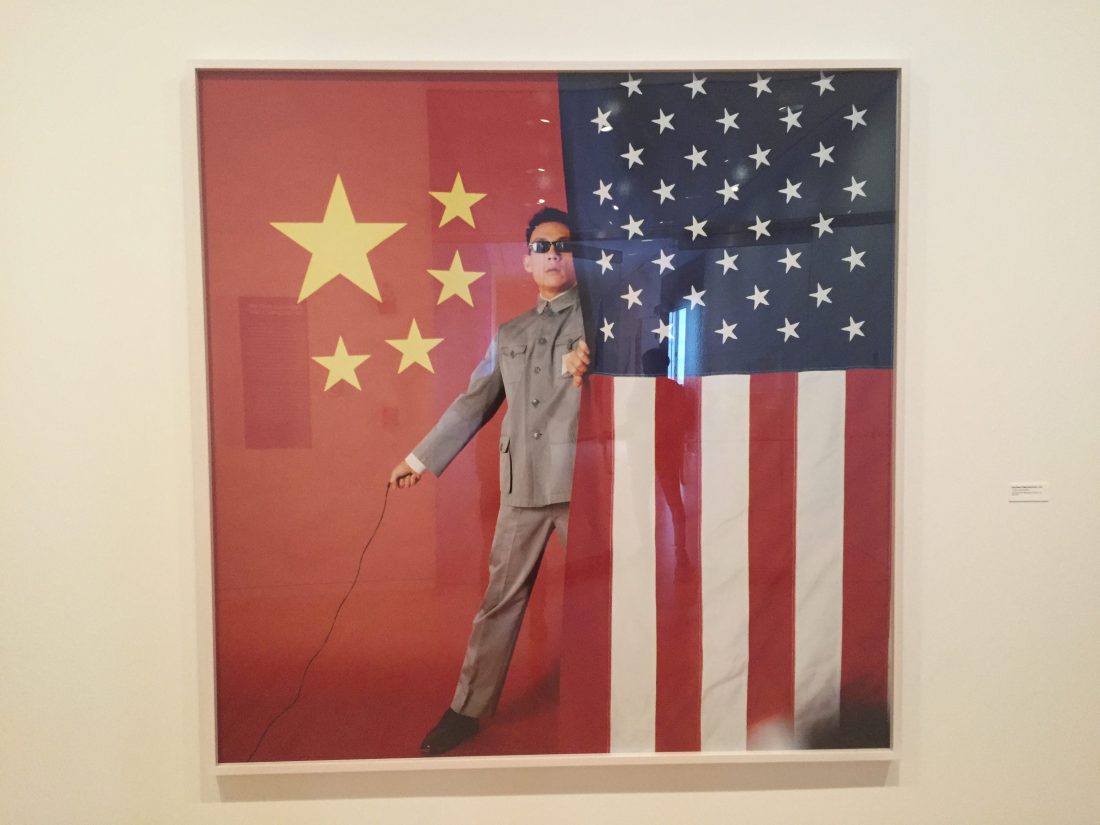By Grant Rindner
Though the term hovered decades away from its place in the lexicon of pop culture, the first retrospective of New York photographer and performance artist Tseng Kwong Chi elevates the selfie beyond something to kill time or send to friends in self-revealing five-second bursts.
Tseng Kwong Chi: Performing for the Camera, is a collection of portraits and performance works culled from Tseng’s portfolio, including many of the iconic shots taken for his East Meets West series in the late 1970s and ‘80s. It’s all on display at Northwestern University’s Mary and Leigh Block Museum of Art through Dec. 11. To commemorate the life and witty, thought-provoking work Tseng created throughout his career, the exhibit includes a tour guided by his sister, the choreographer and dancer Muna Tseng on Oct. 26.
Tseng died of AIDS in 1990 at just 39 years old. He is most renowned for the humorous and surreal shots he took as part of East Meets West, a collection of self-portraits he took clad in dark sunglasses and a Mao Zedong suit in front of iconic American and international settings. The idea came when Tseng wore a Mao style suit to dinner with his family at the Windows on the World restaurant in the World Trade Center – it was the only formal garment he owned, said Block curator Janet Dees explained during her presentation as part of the exhibit opening of “Five Takes on Tseng Kwong Chi.” Tseng’s parents were embarrassed, but he was mistaken for some sort of high-ranking official and treated with reverence.
“East Meets West Manifesto,” presents a striking contrast to the rest of the photographic series on view. It is the sole color picture. The rest are black-and-white and emphasize how Tseng in his tunic suit clashes against backdrops such as Lake Ninevah, Vermont, the National Grasslands of South Dakota and, fittingly, in front of the World Trade Center. “Manifesto” with its dramatic pairing of flags serves almost as a thesis statement for the collection of shots.
“He’s positioned between a U.S. flag and a Chinese flag approximation, pulling back the former as if he, a performer, were coming on the stage,” Dees said of the striking, playful photograph.

Other East Meets West images include the particularly powerful “Niagara Falls, New York,” in which Tseng poses directly in front of the splendid natural scene, mimicking the hapless, wandering gaze of a confused tourist. Tseng’s face literally disrupts the waterfall landscape like many vacation photographs do. The beauty behind him is reduced to an afterthought.
“[Tseng] plays the role of a specter haunting North America, not only (the ghost) of communism but also queerness and race,” said Joshua Chambers-Letson, Northwestern performance studies assistant professor at his opening presentation.
Having these pictures gathered and displayed together reflects on the status of immigrants in American society. Tseng was born in Hong Kong and always presents himself as unsettlingly at odds with his surroundings, whether he’s dwarfing the outline of the Hollywood Hills or smiling gleefully with New York socialites at the Metropolitan Museum of Art, his tan suit distinctly at odds with the all black attire of the in-crowd.
But Tseng’s work is more than solo shots, and Performing for the Camera features his pictures of friends, foes, and fellow artists.. He captured intimate portraits of Andy Warhol deep in thought and Jean-Michel Basquiat sprawled out on what appears to be one of his paintings. These images capture another side of Tseng, who was a seminal figure in the avant-garde Manhattan art scene after moving to New York to live with his sister in 1978.
In other portraits, however, Tseng’s mission to subvert quintessential American symbols and ideas is very much evident. His series Moral Majority consisted of portraits of prominent conservatives like John “Terry” Dolan, who founded the National Conservative Political Action Committee, and author William F. Buckley Jr. The portraits are so blatantly satirical that it’s hard to believe the subjects were not in on the joke as they smile brightly and innocently in front of a severely wrinkled American flag, according to the exhibit text. Tseng told them it would look like it was flapping in the breeze. Like much of Tseng’s work, Moral Majority manages to balance between subtly ironic and glaringly overt in its message.

But perhaps the most stunning image in the Tseng retrospective is not of the artist dressed as an oblivious emissary or snapping a famous friend in a private moment. Tucked in a display case opposite “East Meets West Manifesto” is a spread “The Next Draft’s Command Performance.” Tseng took the photos and gathered the quotes for the short-lived SoHo Weekly News in January 1981. He composed the piece in response to the draft, after all men in 1962 were required to register. Tseng spoke with a number of these registrants, some of whom signed the forms willingly, while many did not.
The pictures in the article aren’t “selfies” like East Meets West, but each of these portraits share a distinct sensibility with Tseng’s most famous work – the portraits feel candid and off-kilter, forcing the viewer to confront the fact that these are the people who will be fighting in America’s next military battles. The quotes from the young men, some of whom were only 15 years old and had registered early, range from fatalistic (“When you go to war, it’s either kill or be killed, so I’d rather kill”) to heartbreaking (“I just want to play the tuba,” a musician responds.) Tseng had asked him if he is willing to kill or lose his life for America.
Tseng Kwong Chi’s brief career illustrated the disruptive power of the portrait, and the work featured in Performing for the Camera is the summation of that vision. Whether you find yourself smirking at the image of Tseng leaping in front of the Brooklyn Bridge or posing with a perplexed Nancy Kissinger, or whether you angrily scan the faces of the men who had just filled out their draft information, the exhibit proves one thing. A portrait is far more than just documentation of a moment in time.


